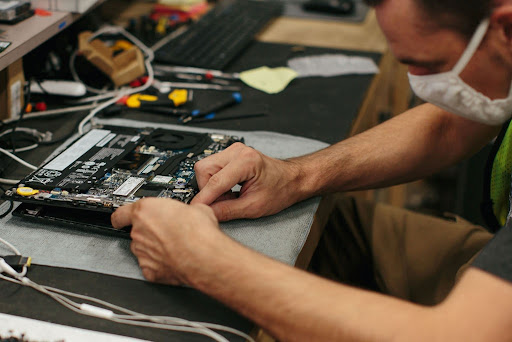
Caption: Recycling could mean fixing the electronics or breaking it down into small components. Photo credit: Photo taken by Monika Hubka at Repowered.
Guest Insider: Kathleen Doran-Norton, League of Women Voters
Maybe it was a button battery, or perhaps a musical birthday card or a laptop that sparked a landfill fire in my township in Rice County. It burned for days – as big as a football field and thirty feet deep. This May 22 landfill fire isn’t an unusual event, but a regular occurrence throughout our state. And it’s expensive. A 2017 landfill fire in Koochiching County cost them half a million dollars.
While Minnesota has a program for recycling electronic waste, it’s old and so specific there are only a few items that are recycled. The rest are landfilled, or as my county commissioner found out, dumped into cardboard recycling dumpsters or left along township roads. In 2007, when the Enhanced Producer Responsibility bill was passed, it supported the collection of 43 million lbs of waste. But because of technology changes, that bill now supports only 20 million pounds of waste. While that may still seem like a lot, it’s estimated that there are 266 million pounds that we could be collecting annually, half of that white goods (home appliances like refrigerators). As a result, those millions of pounds of metals and minerals we need for a renewable energy economy are being tossed away – to spark fires, foul the air as tinder, and pollute the soils and groundwater. Twin Cities landfills are full, and incinerators pollute the air in surrounding vulnerable neighborhoods.
There’s another way.
It starts with updating the MN Enhanced Producer Responsibility bill, so that all e-waste – everything with a cord, a battery or a circuit board – Is collected. And making sure counties are not only reimbursed for everything collected, but incentivized to expand collections. The current manufacturer’s fee isn’t working, because the money goes to recyclers instead of the collectors. Currently manufacturers send their EPR money to the larger Wisconsin recyclers instead of the smaller MN ones, and counties are left with overfilled landfills, and no incentive at all to collect those goods which could be recycled.
After collection and recycling (that is, breaking it down into small pieces), the current process is to ship everything to Asia, where it is smelted down, and either shipped back to the US as raw materials or finished goods. And the cycle repeats. RePowered and the Iron Range Partnership for Sustainability, along with a professor from Macalester have another idea (https://www.irpsmn.org/ewaste-recycling): Collect and recycle 100% of our e-waste here in Minnesota and use abandoned business spaces in the Iron Range to create new businesses which could reclaim minerals and metals in new and sustainable ways, and use those materials to build our new renewable economy. And as new renewable economy businesses, like solar-panel maker Heliene Inc. expand in Minnesota, or new, innovative companies locate here, we will have resources they need.
Look for a draft of the updated MN Enhanced Producer Responsibility bill (referred to as various sections of 1310 – 1330 in MN 115A), which Senator Kupec and Rep. Hollins have expressed interest in sponsoring in the 2024 session, to start us on this path.
For more information watch this video presentation on e-waste, recycling, and circular economy by Kathleen Doran-Norton of the League of Women Voters and Maria Jensen of Repowered.